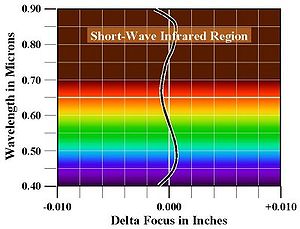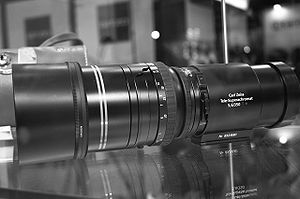
Superachromat
Encyclopedia


Lens (optics)
A lens is an optical device with perfect or approximate axial symmetry which transmits and refracts light, converging or diverging the beam. A simple lens consists of a single optical element...
. The color shift curve of a superachromat is a quartic
Quartic function
In mathematics, a quartic function, or equation of the fourth degree, is a function of the formf=ax^4+bx^3+cx^2+dx+e \,where a is nonzero; or in other words, a polynomial of degree four...
, meaning that in theory four separate colors can be brought to focus
Focus (optics)
In geometrical optics, a focus, also called an image point, is the point where light rays originating from a point on the object converge. Although the focus is conceptually a point, physically the focus has a spatial extent, called the blur circle. This non-ideal focusing may be caused by...
in the same plane, while simultaneously correcting spherical aberration
Spherical aberration
thumb|right|Spherical aberration. A perfect lens focuses all incoming rays to a point on the [[Optical axis|optic axis]]. A real lens with spherical surfaces suffers from spherical aberration: it focuses rays more tightly if they enter it far from the optic axis than if they enter closer to the...
and field aberrations. This near-perfect correction of chromatic aberration
Chromatic aberration
In optics, chromatic aberration is a type of distortion in which there is a failure of a lens to focus all colors to the same convergence point. It occurs because lenses have a different refractive index for different wavelengths of light...
is highly beneficial in film and digital multi-spectral
Multi-spectral image
A multispectral image is one that captures image data at specific frequencies across the electromagnetic spectrum. The wavelengths may be separated by filters or by the use of instruments that are sensitive to particular wavelengths, including light from frequencies beyond the visible light range,...
photography
Photography
Photography is the art, science and practice of creating durable images by recording light or other electromagnetic radiation, either electronically by means of an image sensor or chemically by means of a light-sensitive material such as photographic film...
, as a superachromat can focus near-infrared energy in the 0.7 to 1.0 micrometer wavelength band in the same focal plane as visible light, eliminating the need for refocusing. Unfortunately, due to the limited selection of optical glasses and partial dispersion
Dispersion (optics)
In optics, dispersion is the phenomenon in which the phase velocity of a wave depends on its frequency, or alternatively when the group velocity depends on the frequency.Media having such a property are termed dispersive media...
properties, superachromats must be manufactured with costly fluorite glass
Fluoride glass
Fluoride glass is a class of non-oxide optical glasses composed of fluorides of various metals. Due to their low viscosity, it is very difficult to completely avoid the occurrence of any crystallization while processing it through the glass transition...
es and to very tight tolerances.

